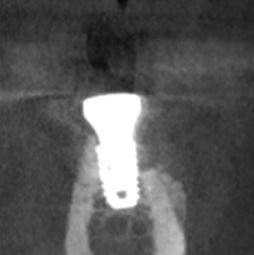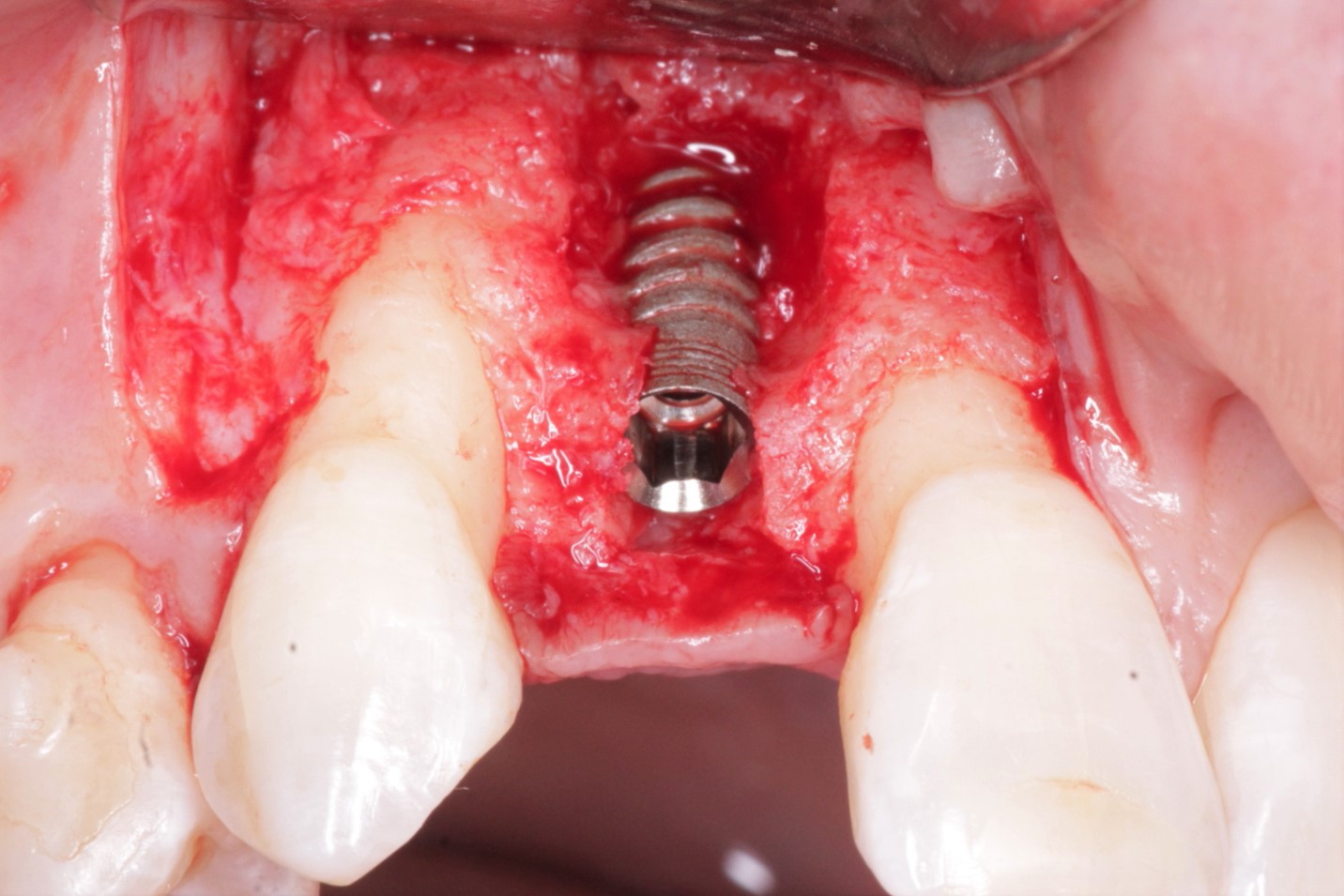CT-based Planning for Dental Implants
Some of our subscribers believe that the real major paradigm shift in implant dentistry, is towards CT-based Planning for Dental Implants. What are your thoughts?
14 Comments on CT-based Planning for Dental Implants
New comments are currently closed for this post.
Anon
5/16/2005
Perhaps the most important factor in implant placement, using these techniques, is the ability to be guided by the system in the implementation of the pre-treatment plan. Such systems as the IGI system (DenX) not only provide for precise treatment planning using a distortion-corrected CT scan, they completely guide the surgeon through the implant placement using the treatment plan and a real time image of the patient's anatomy, each of the surgical tools and the implant being placed. Further, in the absence of a rigid template, the dentist can vary from the treatment plan if it is absolutely indicated.
Anon
5/17/2005
There is no doubt that 3D imaging does add to the information we have, and the accuracy in planning our cases. But the benefit of actual CT based, real time, guidance at the time of surgery is also now a reality. See the Image Guided Implantology (IGI) from Denx for info about this amazing break-through, as presented at the recent Academy of Osseointegration meeting in Orlando.
Anon
5/17/2005
To the May 17, 2005 04:20PM commentator.
While I accept the IGI system as the state of the art in this newest implant support technology (I believe that a surgeon from Boca won an award for a presentation on the IGI at the Orlando AO meeting), is this technology for its own sake or have you directly experienced some of the benefits promised by this technlogy?
darryl
5/17/2005
Having used the Morita scanner for a few months there is (for me) no going back. It allows key hole single stage surgery without any larger radiation dose than a panoramic.The cross sectional resolution is superb and the stress is reduced.Sinus lifts or ridge expansion with this in combination with Piezosurgery are fast and comfortable for the patient.
Dan
5/17/2005
I don't think that CT scanning should be done in every case. We need to be diagnosticians when it comes to using the tools we have available. However, I have used SimPlant in several cases that I thought might be complicated, and it completely changed my treatment planning. Being able to see into sinuses before doing sinus lifts is indispensible. Often I have found polyps or mucosal thickening that made the procedure impossible,which I found out before I did the surgery. Recently, I placed four implants in the symphysis where I had to remove 20 mm of bone before I got enough width to place the implants. I would have been completley unprepared for this if I hadn't done a CT scan and then had a bone model made.
Roy
5/18/2005
More info prior to implant placement is helpful in all but the obvious slam dunk surgeries. Keeping the image cost down to $250-300 per arch helps as well. I've seen a rise in my own implant failures/aborts that have been done "flapless" and without a CT. When in doubt flap (although it may be a little late) or image prior to placement.
ScottNJ
5/19/2005
Imaging and interactive CT is the only way to take the guesswork out of what we do... why guess? However, we must still keep in mind that "It is not the scan, it is the plan." Therefore you can get a scan on each patient, but without the proper planning, the design of the template can still be incorrect...
Check out my latest article for the radiologists... at www.aadmrt.com and for additional information or articles see the website at www.drganz.com.
Anon
5/23/2005
Scott is 100% correct in saying that without the proper planning, the template can still be incorrect, and in this case will guide you perfectly towards a mistake. Not all guidance systems are, however, limited to the use of rigid templates. Denx's IGI and the Robodent allow real time virtual visualization of the implant site and the tip of the burr. I believe that of these two systems only the IGI has full FDA clearance as of this moment. Robodent will no doubt get it in the next year or so. Even these flexible systems require care in planning - the brains are in the dentist, not the computer. Expert systems will soon be combined with planning and guidance, and provide guidance not only of the drill bit, but will assist the dentist in treatment planning.
Anon
5/26/2005
I totally agree with the last post. Why anyone would prefer a 2 dimensional x-ray over a 3 dimensional x-ray is beyond me. Now that 3 dimensional x-rays can be combined with computer guided tracking systems, the ability to do cases that would never have been attempted before will be common procedures.
DR.SATISH A. JOSHI
6/4/2005
WITHOUT GOING INTO DETAILS OF MERITS AND DEMERITS OF CT-SCAN LET ME GIVE JUST TWO EXAMPLES.
1,
ONE OF MY REFERING DENTIST SEND ME PAN X -RAY,PERIPICALS AND STUDY MODELS FOR A YOUNG BOY OF 19 FOR MISSING TOOTH NO.9.
AT FIRST SIGHT, CASE WAS SCREAMING "GO HEAD".
BUT AS A SECOND THOUGHT I DICIDED FOR CT SCAN AND GUESS WHAT, DUE TO LARGE INCISIVE CANAL AND PROXIMITY OF NO.10 I MAY NEED TO BE VERY PRECISE AND USE 3.3MM IMPLANT ONLY AND HELP OF AN ACCURATE SURGICAL STENT.
2,
ANOTHER REFERING DENTIST SEND ME A PATIENT FOR REPLACING TEETH NO.20,19 AND 18.
PATIENT HAD ALREADY VISITED REFERING DENTIST'S ORAL SURGEON AND FROM PAN x-RAY PATIENT WAS TOLD THAT HE DOSE NOT HAVE ENOUGH HEIGHT OF BONE AND SO COULD NOT HAVE IMPLANTS WITHOUT EXTENSIVE SURGERIES.
GUESS WHAT,
I ORDERED CT SCAN AND FROM THE INFO FROM CT SCAN I WAS ABLE TO PLACE 11.5 MM LONG IMPLANTS AND STILL STAY AWAY 1MM FROM CANAL.
NOW YOU GUYS DECIDE.
Ken Abe DDS
6/9/2005
I have been using CT scans and stents for virtually every implant I have placed since about 1995. I think the key reason why surgeons do not see the value in CT scans in placing implants is the problem with transferring the data they see on the CT scan to the mouth in an accurate manner. Angulations and position of placement can be estimated with software but transferring that data to the mouth accurately is still done by an estimate. I was glad to finally see the ability to correlate a stent to the CT scan commercially at the SF Osseointegration convention. I have been using CT scans and Stents with "tube" markers since about 1995 and was using stents with "guide tubes" since 1993 to accurately place implants in 3 dimensions while also controlling depths. I would not place an implant without them. They not only allow accurate implant placement in 3 dimensions but also allows pre-planning of abutments, restorations and aesthetics. They also allow placement of the longest implants possible in a given situation by allowing closer placement tolerances to critical structures (ie. nerves, the sinus and adjacent roots. I believe this greately improves success rates from a restorative as well as surgical point of view.
Frank
6/23/2005
What do you think of the technology out of the Israel company that Nisnick is so heavily invested in?
fmn
Anon
3/22/2006
I have personally used the IGI system for surgical Navigation based upon a CT scan. With the exception of the easy straight forward case, I can not think of doing surgery again without these tools. Treatment planning with the restorative dentist using the computer planing software (DENX)and the 3-D scan provides insight into the case that could never be achieved with conventional diagnostic tools. I have been able to offer options to patients with complex cases that i may not have attempted before. Real time surgical guidence provides more accuracy and flexibility for the surgeon over surgical templates. For our surgical practice this technology is such a benefit for predicable treatment that it is become the standard of care for us.
Robert J. Miller
7/23/2006
For the past year and a half, we have been doing the clinical trials for RoboDent in the US. As a second generation surgical navigation device in laptop form, the accuracy and ease of ease has been enhanced significantly. While we do not use this device for all of our surgeries, ALL of our cases get a DVT scan, and have some type of guided device for implant placement. The more complex cases then become more routine as our confidence and ability to accurately place implants is enhanced. There is a profound change in the standard of care coming in both pre-op planning and surgical execution in implant dentistry.

















